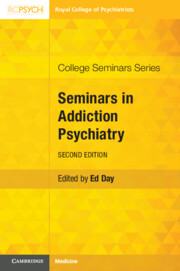Book contents
- Seminars in Addiction Psychiatry
- College Seminars Series
- Seminars in Addiction Psychiatry
- Copyright page
- Contents
- Contributors
- Preface
- Chapter 1 Historical and Conceptual Approaches to Addiction
- Chapter 2 Illicit Drug Use: Epidemiology, Aetiology and Prevention
- Chapter 3 Illicit Drug Use: Clinical Features and Treatment
- Chapter 4 Addiction to Prescription Medication: Benzodiazepines, Z-Drugs and Gabapentinoids
- Chapter 5 Alcohol Use Disorders: Epidemiology and Prevention
- Chapter 6 Alcohol Use Disorders: Aetiology and Pathophysiology
- Chapter 7 Alcohol Use Disorders: Clinical Features and Treatment
- Chapter 8 Psychological Approaches to Addiction
- Chapter 9 Comorbid Substance Use and Mental Illness
- Chapter 10 Medical Aspects of Drug and Alcohol Use
- Chapter 11 Organising Treatment Services for Drug and Alcohol Misusers
- Chapter 12 Tobacco Use Disorders
- Chapter 13 Novel Psychoactive Substances and Club Drugs
- Chapter 14 Addiction Problems in a Family and Social Context
- Chapter 15 Addiction Recovery Mutual-Aid Organisations
- Index
- References
Chapter 2 - Illicit Drug Use: Epidemiology, Aetiology and Prevention
Published online by Cambridge University Press: 02 November 2021
- Seminars in Addiction Psychiatry
- College Seminars Series
- Seminars in Addiction Psychiatry
- Copyright page
- Contents
- Contributors
- Preface
- Chapter 1 Historical and Conceptual Approaches to Addiction
- Chapter 2 Illicit Drug Use: Epidemiology, Aetiology and Prevention
- Chapter 3 Illicit Drug Use: Clinical Features and Treatment
- Chapter 4 Addiction to Prescription Medication: Benzodiazepines, Z-Drugs and Gabapentinoids
- Chapter 5 Alcohol Use Disorders: Epidemiology and Prevention
- Chapter 6 Alcohol Use Disorders: Aetiology and Pathophysiology
- Chapter 7 Alcohol Use Disorders: Clinical Features and Treatment
- Chapter 8 Psychological Approaches to Addiction
- Chapter 9 Comorbid Substance Use and Mental Illness
- Chapter 10 Medical Aspects of Drug and Alcohol Use
- Chapter 11 Organising Treatment Services for Drug and Alcohol Misusers
- Chapter 12 Tobacco Use Disorders
- Chapter 13 Novel Psychoactive Substances and Club Drugs
- Chapter 14 Addiction Problems in a Family and Social Context
- Chapter 15 Addiction Recovery Mutual-Aid Organisations
- Index
- References
Summary
This chapter begins with an exploration of the epidemiology of illicit drug use. Measuring the use of illicit drugs accurately can be challenging, and the initial focus is on the various potential sources of data in the UK. Methods for estimating the prevalence of opiate and crack cocaine use are discussed, and the prevalence and trends in both specialist addiction and mental health services are reviewed. The aetiology of drug use and dependence is then explored using a framework of risk and protective factors. The brain disease model of addiction is described alongside challenges to its validity, with a consideration of why some people get addicted and others do not. Psychological models of addiction are reviewed and integrated into a wider biopsychosocial model. Finally, protective factors against drug use in adolescence are considered, and the evidence for prevention strategies summarised.
Keywords
- Type
- Chapter
- Information
- Seminars in Addiction Psychiatry , pp. 15 - 41Publisher: Cambridge University PressPrint publication year: 2021



